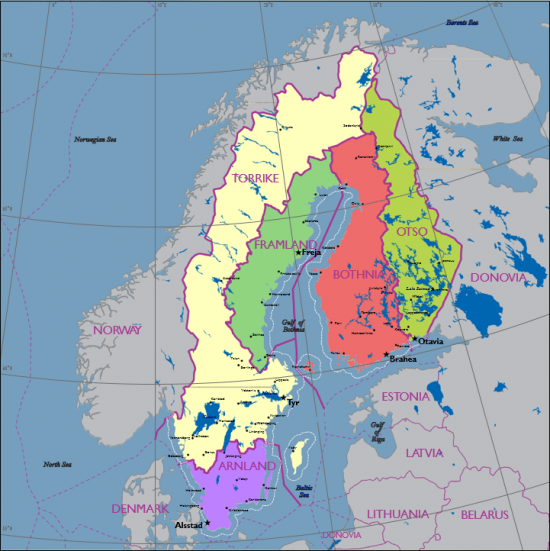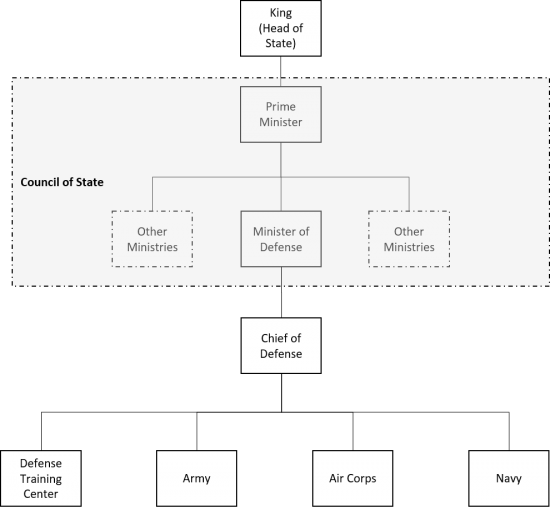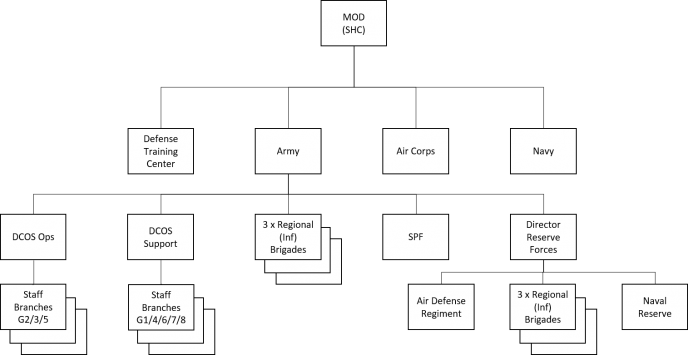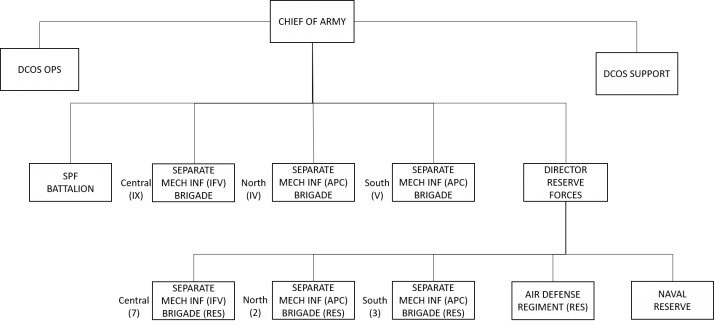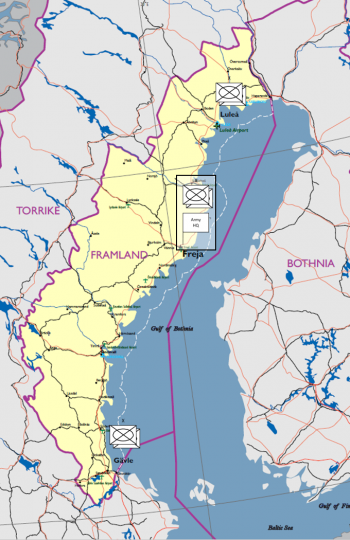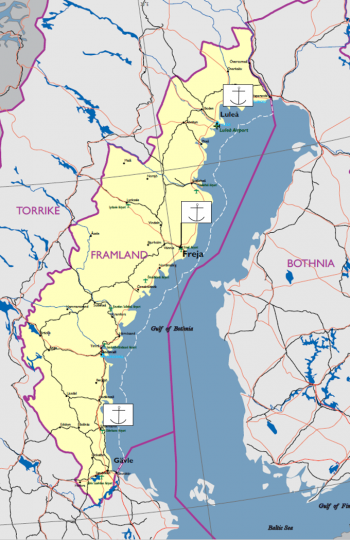Military: Framland
DATE Europe > Framland > Military: Framland ←You are here
Military Overview
The Framland Defense Force is unusual within the region, in that it is all volunteer and does not rely on conscription. It is also the smallest force in the region by a considerable margin; the regular forces number around 20,000, with an additional 14,000 in the Reserves. Technically, there is a single Defense Force with three branches of service; however, in effect it comprises of three separate services each with its own HQ structure, training organizations and uniform. The organization of each of the services is extremely conventional and the structure reflects that of a much larger force. There is a reserve structure underpinning the Army and the Navy, but no reserve force for the Air Force. The Coast Guard is a separate organization from the Defense Forces, although it is linked to them. Notwithstanding their small size, the forces in general, and the Army in particular, have built up considerable operational expertise through deployments on United Nations (UN) and associated missions. Framish troops are very highly regarded by the UN and all other forces that they have served alongside and the forces have a tradition of professionalism and excellence that belies their limited capabilities. The Framish government see the Defense Forces as a useful diplomatic tool in building stability throughout the world.
Strategic Perception
Framland sees itself as a minnow in a pool of sharks. It is extremely aware of the grandiose strategic visions of both Torrike and Bothnia and the potential for confrontation, if not actual conflict, with either of those countries. It is also conscious that its geographic position between the two renders it uniquely vulnerable in the event of a conflict between them. Occasional efforts by Torrike to ‘influence’ Framish actions or opinions serve as a useful reminder of the potential their neighbor has to disrupt relations. In a broader regional sense, the situation in Arnland is seen as a source of instability that, if unchecked, could cause considerable disruption to the locality. Even if there is no deterioration of the situation in Arnland, Framland is concerned about the adverse effects that any spillover of organized crime activities in Arnland may have in the region. Framland is a member of the UN and a firm supporter of international political organizations.
Notwithstanding these perceptions, Framland cultivates, and enjoys good relations with both of its larger neighbors and with other countries within the region as a whole. It continues to build its relationship with both the North Atlantic Treaty Organization (NATO) and the European Union (EU), albeit keeping them at arm’s length. The relationship with Donovia is also good.
Defense Policy and Priorities
Although Framland’s Defense Policy is subject to review on a five year basis, the basic tenets of neutrality and self‐sufficiency have been unchanged since the First World War (WWI). Current defense policy was promulgated in 4 years ago and can be summarized as to provide for the military defense of the state, contribute to national and international peace and security and to fulfill any other roles assigned by the government. Expenditure of defense is normally around 1% of the gross domestic product (GDP).Framish terminology on defense can be a little misleading. In the broadest terms, the term ‘defense’ is used to describe defense provision within the nation comprising both civil and military elements; ‘defense organization’ refers to the combined civil and military organization, while ‘defense Forces’ refers to the specifically military organization.
Arctic Military Strategy
National Command Authority
In keeping with the country’s modern and western outlook, the armed forces are completely apolitical. The formal Supreme Commander of the Armed Forces is the King and members of the forces take an oath of loyalty to the King, but in practice, the forces answer to Parliament through the Minister of Defense. The ultimate control of the armed forces and their employment is civilian and political.
Ministry of Defense (MOD)
The Framland Defense Forces structure is conventional with a central MOD staff under the Chief of Defense Forces (CHOD) reporting to the Minister and advising him. The CHOD’s staff acts as a General Staff, but there is no joint operational HQ. Underneath the central staff, there is the Army, Naval Service, Air Corps and the defense Training Center. The Air Corps is technically a branch of the Army, but operates as a distinct service. Although a separate organization, the Coast Guard has close links with the Naval Service. Civil defense is the responsibility of the Ministry of the Interior.
Military Forces Overview
Framland is unique in the region in maintaining fully professional armed forces, conscription having been abolished in the 1960s. The assumption then was that with a small population and a limited defense budget, a small, all professional, force would be more effective than a large and under equipped conscript force. This remains the consensus. Back up for the regular forces is provided by the Defense Reserve Force (DRF), a part time force that mirrors the organization of the regular forces. Loosely modeled on the British Territorial Army, it is largely regionally based. The DRF’s members are a mix of retired professionals and volunteers. Its operational capability does not match that of the regular forces, although some DRF troops have been deployed on peace keeping missions and together with the former regular members, provides an element of operational experience to the force. In total, the regular forces number around 20,000, with an additional 14,000 in the DRF.
Personnel enlist initially for a period of four years, with the option to leave the forces in the first 4 months of training if they decide that they do not wish to pursue a military career. Beyond the four year point, there are a range of engagement options, but the norm is to sign on for a 20 year term. Only the most senior Warrant Officers and specialists serve beyond the 20 year point. The majority of officers are recruited directly, but approximately 15% of officers are commissioned from the ranks. Most officers are educated to degree standard, but this is not compulsory. Officers initially sign up for an 8 year commission, after which they may be selected for a full career of 22 years. Only the most senior ranks of the service and selected individuals serve beyond this point. There is no formal age limit for officers as such, however, on promotion to Colonel, officers are only guaranteed one tour; service beyond this point is at the discretion of the CHOD. In effect, the Defense Forces’ solution to maintaining a promotion and career structure is to keep the turnover of the senior ranks steady. One unintended result of this approach is that Framish senior officers tend to be younger than their equivalents in many other nations.
Framland possesses only a very limited defense industry, largely restricted to the simpler elements of repair and maintenance. Equipment for the forces is widely sourced and the forces are content to purchase surplus or second hand weapons systems. Framland does try and balance purchases from Torrike and Bothnia with more broadly sourced equipment, while Torrike in particular seeks to use defense sales to Framland equipment to gain influence.
There are elements of cooperation between the states with Torrike providing Framland with air defense information and some training support; Bothnia, Torrike, Framland and Arnland share maritime traffic information for the Baltic Sea and coordinate search and rescue (SAR) activities.
Military Doctrine
Framland is under no illusion as to the relative capabilities of its Armed Forces vis-a-vis its neighbors. In light of this, its strategic military doctrine is aimed very much at the interaction of all the relevant political, economic and military instruments so as to ideally avoid confrontation, or in the worst case, bring it to a swift and satisfactory conclusion. In the event of an attack, the military contribution is, in essence, to delay any aggressor sufficiently to allow diplomacy and the political instruments to achieve an acceptable end state. In light of this approach, the key tenets of Framish military doctrine can be summarized to the effect that “Force, or the threat of force is the means to achieve the target of convincing the adversary that it is better to end the conflict, than to continue it”. Under this concept, the key elements of military doctrine are:- Restrain: Convince the enemy that his actions will not succeed, or are not worth the sacrifice he will have to make to achieve them.
- Hinder: Use force, or the threat of force to actively prevent an adversary from using his resources or acting. It is recognized that the deployment or military means of power may lead to escalation as it may be seen as a hostile act.
- Disorganize: Break the coordination and morale of the opposition’s organization in order to reduce their will to carry out operations. This is achieved through the systematic targeting of coordination functions.
- Defeat: Systematically inflict damage and loss on the opposition’s forces through the direct application of force.
Framland’s tactical doctrine is taken from a large variety of sources, including the British, French and German forces, which are adapted to Framland’s perceived circumstances.
Command and Control (C2)
The C2 arrangements for the Armed Forces are highly conventional. There is a small central staff in Freja under the command of the CHOD, which is designated as a General Staff. In addition, the country is divided up into 3 Brigades (Northern, Central and Southern), each with responsibility for the operational and administrative control of its area. Within the MOD structure, there is the Situation Center, a fully equipped operations center that is manned on a skeleton basis during peacetime. This consists of a small monitoring team and representatives of the Coast Guard, Police and Civil Defense organizations. The center coordinates SAR activities within Framland’s area of responsibility and with the Torrikan and Bothnian authorities in the wider region. Additionally, it receives the feed of air defense data from Torrike and functions as the Air Corps’ air defense tasking cell. In the event of a crisis, the center stands up formally and assumes command of all forces, functioning as the operational HQ for the defense of the realm. Once this has been activated, the center contains the full range of planning and operational staffs, mostly drawn from the General Staff, but with augmentees from the Services own HQs. Deputy Chief of Staff-Support (DCOS) Ops assumes the role of Operational Commander, while his deputy acts as the Ops Center’s Director.
There is, therefore, no standing joint operational HQ and the Air Corps and Naval Service have separate tasking cells with liaison elements in each of the Brigade HQs to coordinate air and naval support to the Army.
Roles and Missions
The Framland Forces identify the following missions:
- To defend the State against armed aggression.
- To provide aid to the civil power (Military Aid to other Government Departments; MACP and MACC) as and when directed by the Government.
- To support the United Nations by participating in UN mandated peace support, crisis management and humanitarian relief operations, as directed by the Government.
- To provide a fishery protection service in close cooperation with other Baltic Sea States.
- To discharge any other such duties as may be assigned to them by the Government, including, but not limited to, SAR, air ambulance services, VIP air transport, assistance on the occasion of natural or other disasters, assistance in maintaining essential services, assistance in combating pollution at sea, etc.
Leadership
The rank structure of the Framish Armed Forces reflects their small size. The CHOD is the sole three-star officer, and there are only two-star posts in the Defense Forces. The normal tour length for these appointments is three years.
Strategic Capabilities
Framland possesses no strategic capabilities.
Military Intelligence
The small military intelligence organization, Military Information Bureau (MIB), is part of the central administration of the Ministry of Defense. This is closely linked to the national intelligence service, FFIS (Framish Foreign Intelligence Service) in regards to information sharing and personnel training. The Police Security Service of Framland provides services to the armed forces in the areas of military counterintelligence, information security and advises on personnel vetting as well as security of military installations, procedures, force protection and material.
Army Overview
The Army employs a conventional Brigade structure, with three regional Brigades reporting to the Army HQ in Freja. This structure is mirrored by the Reserve Forces element which, nominally, can provide an additional three Brigades on mobilization. Technically, the Air Corps is a branch of the Army, but it prefers to portray itself as separate. The Army includes all the traditional branches of service (infantry, armor, artillery, engineers, ordnance, communications, intelligence, medical, transportation, and military police). There is also a small special reconnaissance force.
Army Command and Control (C2) and Structure
In effect, the MOD is the Army HQ. The CHOD is both head of the Armed Forces and Chief of the Army. Since the Naval Service and Air Corps are technically branches of the Army, this does not preclude members of either service becoming CHOD. The majority of staff within the MOD are dual hatted, dealing with both Army specific and broad MOD issues.
Each Brigade HQ also serves as the regional defense HQ, with air and naval planning and liaison cells as well as civil defense and police liaison officers. The Brigade commander is responsible for planning and executing the defense of his region and for contributing to the construction of the overall defense plan for Framland.
The structure of the brigades is standardized; each has three infantry battalions plus organic armor, artillery, communications, intelligence, engineering, and logistics support. This structure is mirrored by the Reserve Forces, which in peacetime are treated as a single brigade, but expand to match the regular forces on mobilization. Each brigade also controls an air defense battery, with an additional regiment contained within the Reserve Forces structure.
Army Roles and Missions
The primary mission of the Army is the defense of the territorial integrity of Framland against any external aggression. In addition it is the main defense source of Aid to the Civil Power, particularly in terms of manpower and engineering support for disaster relief. Finally, as a contribution to the country’s support to the international community, it is responsible for the training and preparation of all servicemen and units deploying on UN missions. Below the MOD level, each Brigade is responsible for the organization and execution of the defense of its home region and for the integration of the Reserve Forces into their regional command structure after mobilization.
Army Leadership and Intent
The compact nature of the Army’s command pyramid means that promotion to the top ranks is extremely competitive. This has an effect throughout the officer structure. Advancement is predicated on professional performance and so officers have an extremely focused approach to their calling. Deployments on UN operations have emphasized the importance of initiative and the value of the delegation of responsibility to the lowest possible level. The combination of these factors has produced an officer corps that is well educated, well trained, confident and extremely professional.
The current vision for the Army is that of a modern and integrated force that uses its resources intelligently to achieve the maximum effect for its size.
Army Training and Readiness
Army training can be divided into three categories:
- Initial recruit training and individual continuation training
- Unit and formation training
- All arms (joint) training
The DTC is responsible for the planning and management of the first category, running the various military and technical schools necessary to keep a modern force effective. This includes basic training, junior and Senior NCO command schools, officer training and staff training courses as well as technical training in conjunction with a number of commercial and academic institutions. The DTC also plans and manages the arms specific training such as the basic infantry course, or armored reconnaissance course, in conjunction with the relevant branch of the Army. The DTC also produces the reservists training programs, in conjunction with the Director of Reserve Forces.
Unit and formation training is the responsibility of the regional Brigade HQs and essentially follows a two year plan.
Army Personnel and Equipment
In total, there are 14,500 personnel in the Army; turnover is fairly low, with between 800 and 1,000 recruits being inducted each year. Fitness and professional standards remain high throughout a serviceman’s career and these are regularly tested.
The Army’s equipment program is driven by a combination of pragmatism and funding. A keen appreciation that ‘the best is the enemy of the good enough’ is visible throughout the Army. Much of the equipment is old, but functional, and items tend to be taken out of service only when they have exceeded their usefulness. As an illustration, the decision to retire the main battle tank (MBT) force in early 2000 was taken on the grounds that they were expensive to maintain, and their utility in the numbers that Framland could afford was questionable. A number were sold, but a few are still held in reserve. Similarly, the Scorpion/Scimitar combination is verging on the obsolescent, with the 76mm gun of the Scorpion being ineffective against most modern armored vehicles.
Special Forces
The Army operates a small Special Forces unit, the Special Reconnaissance Wing (SRW). As its name implies, its function is to perform deep reconnaissance for the Army, including targeting. The wing consists of a single squadron (reinforced company) and a training and selection squadron. The Naval Service has the small specialist diver unit which provides specialist assistance to the SRW. Hostage rescue and negotiation are considered to be police specialties and the military has no capability in this sphere.
Framland’s maritime force is to all intents and purposes, a coastal patrol and defense force. The NS is Framland’s principle maritime agency (the Coast Guard is the other) with a general responsibility to meet potential and actual defense requirements. The force has a total of eight surface vessels and a number of inshore patrol boats. The NS describes itself as a constabulary navy, which is probably the best summary of its capabilities and nature. In total, there are some 2,000 personnel in the regular service, with an additional 1,000 in the Naval Reserve.
NS Command and Control (C2) and Structure
The NS has a tripartite organization, with an Operations Command, a Support Command and the Naval College subordinated to Naval Service Headquarters (NSHQ) in Freja. The Flag Officer Naval Service (FONS). The two subordinate commands are collocated with the NSHQ.
Naval Service Operations Command (NSOC). The NSOC is tasked with the conduct of all naval operations, both afloat and ashore and commands the operational resources of the Naval Service. Coordination cells reporting to the NSOC are located in each of the regional Brigade HQs.
Naval Service Support Command (NSSC). The NSSC is responsible for all the support aspects of the service, including Personnel, Logistics and Technical support. The command is split into a number of departments:
- HQ
- Dockyard
- Logistics
- Weapons and ordnance
Naval College. Basic military training for all personnel within the Framish Defense Forces is the responsibility of the Defense Training Center. The Naval College is responsible for all subsequent training within the Naval Service. Its primary function is to train personnel to be able to conduct effective maritime operations in defense of the State. As such it covers basic, continuation and specialist training for all members of the service. The college HQ is responsible for administration of the three schools that comprise the college proper:
- The Naval Officer Training School (NOTS)
- The Maritime Operational Training School (MOTS)
- The Naval Engineering School (NES)
NS Roles and Missions
The Naval Service’s basic missions are to meet the potential and actual maritime defense requirements of the State and to deter intrusive or aggressive acts against Framland through presence, surveillance and interdiction operations. In broad terms, this translates into the following tasks:
- The defense of Framland’s territorial waters
- The deterrence of potential aggressors
- Maintenance of an armed naval presence in Framland territorial waters and the Baltic Sea
- Maritime Surveillance
- Ensuring the right of passage
- The protection of marine assets
- The provision of support to Army operations with sea lift or Naval Gunnery Support (NGS), where required
- The provision of aid to other government departments or the civil power
- The provision of assistance at sea to those in distress
- The provision of fishery protection
NS Personnel and Training
In total, there are some 3,000 personnel serving in the NS. The normal initial contract is for six years (as opposed to four for the Army), but many personnel go on to serve for a full career of 20 years. The result is that there is only a small turnover of staff each year and the force’s corporate knowledge and expertise remains extremely constant. There is a small reserve force, but for the most part, their function is to provide base protection companies for the NS in the event of a conflict.
Apart from basic military training which is the responsibility of the DTS, all aspects of naval training come under the auspices of the Naval College commanded by Captain (Navy) Jogha Lindskog. The College has extremely close links with the Royal Framish National Maritime Institute (RFNMI) in Freja and much of the generic maritime training is actually conducted by the RFNMI. In essence, the RFNMI provides the NS with access to state of the art training facilities for non‐military maritime matters. So while basic maritime military induction training is performed by the College proper, cadets and recruits attend the RFNMI for modules such as navigation, sea survival and firefighting. Additionally, much of the training on seamanship, communications and logistics is performed by the RFNMI. The small specialist schools within the Naval College then add the finishing military touches. Office and SNCO professional (command) training is the responsibility of the NOTS, while specialist engineering training and standards are covered by the NES.
Naval operations training and exercises are run by the MOTS, which covers all aspects from the basics of patrolling up through tactical operations and planning to cooperation with the Army and Air Corps. MOTS is also responsible for operating standards and runs the Fleet Readiness Assessment Course (FRAC). All newly commissioned vessels and ships out of refit are subjected to an individually tailored program designed to bring the vessel up to the designated operating standard in terms of efficiency and crew integration. Each ship then repeats the FRAC after each change of command. MOTS also plans and prepares the annual joint exercise between the NS and the Army and Air Corps. The actual exercise is run by the Operations Command.
Air Corps Overview
As is the case for the rest of the Framish Forces, the Air Corps is both small and limited in its capabilities. However, it is deemed by Framland to be adequate for its purpose. Technically a branch of the Army, the Air Corps has a considerable degree of autonomy and likes to present itself as an independent service. The nature of its activities tends to emphasize this approach, however, in the final analysis, the Chief of the Air Corps reports to the Chief of the Army. The force is spread very thinly throughout Framland and since its prime function is to support the other two branches of service, so the point is perhaps moot.
Air Corps Command and Control (C2), and Structure
The C2 structure of the Air Corps reflects its aspiration to be seen as an independent service. The Air Corps HQ comprises three elements: the Commander’s staff (A1, A7, A8), the Operations Section (A2, A3, A5), and a Support Section (A4, A6 and technical staff). The HQ is responsible for strategic management planning, operational control and planning, personnel and logistics management and airworthiness of all the service’s aircraft. The Air Corps proper is split into a number of Wings, each of which covers a discrete function and the Air College:
- No. 1 Wing: Air defense and air observation
- No. 2 Wing: Maritime patrol, search and rescue (SAR) and police/air ambulance support
- No. 3 Wing: Rotary wing operations
- No. 4 Wing: Transport and VIP transport
- No. 5 Wing: Aircraft scheduled maintenance
- No. 6 Wing: Support functions (Logistics, communications and information systems [CIS], medical, air traffic control, etc.)
- Air College: All aspects of Air Corps specific training
Air Corps Roles and Missions
The Air Corps has two primary missions derived from the overall defense missions:
- To maintain the integrity of Framland’s airspace (Defend the State).
- To support the Army (including the Naval Service) (Defend the State).
Support to the Army encompasses a number of roles:
- Observation and reconnaissance.
- Local fire support/ light strike.
- Tactical mobility and logistic support.
- Maritime surveillance and defense
Secondary roles include:
- Maintaining and flying police and air ambulance helicopters.
- SAR operations over land and sea.
- Aid to civil authorities.
- VIP air transport service.
- Pollution surveys.
Air Corps Personnel and Training
With personnel strength of only some 3,500, the Air Corps is one of the smallest in Europe. The Air Corps uses the same ranks and insignia as the Framland Army.
All non‐operational training conducted by the Air Corps is the responsibility of the Air College. The Air College is divided into three wings:
- Military Training Wing (MTW): Responsible for military training of new recruits (except basic induction which is performed by the DTC) and air specific career courses. The MTW also runs the Framish Forces Survival School.
- Flying Training Wing (FTW): Responsible for both officer training and flying training for the Air Corps. The sole exception to this is fast jet training, which is performed in the United States under a Government-to-Government memorandum of understanding (MOU).
- Technical Training Wing (TTW): Responsible for training aircraft mechanics and electrical engineers.
Operational training is planned and managed by the Air Corps HQ A7 staff in conjunction with either the regional Brigade HQs or MOD, depending on the scope of the exercise. The majority of the training, other than basic continuation training is conducted with at least one if not both of the other branches of the Armed Forces.
Joint Logistics and Capabilities
Procurement for the Defense Force as a whole rests with Deputy Chief of Staff-Support (DCOS SPT) of the General Staff. Technically, all logistics support of the forces is Joint, since there is a single logistics chain. There are specialists within the Air Corps and Naval Service who deal with the peculiarities of those branches, but for the most part, the Army provides, stores and moves all the logistics needs of the forces.
Framland has no real Joint Capabilities as such except for the provision of medical care through its combined Medical Services. Each branch of the Defense Forces has clearly defined responsibilities and there are virtually no overlaps. The Air Corps functions are subordinated to the needs of the other services and with the sole exception of air defense, it only operates in conjunction with the other services. The Naval Service has the most autonomy, but even here, operational direction is closely coordinated with the regional Brigade structure.
Medical
Framland has a small medical establishment that is responsible for primary healthcare of members of the forces and for the provision of medical support to deployed units. There are no military hospitals, but Defense Medical personnel have provided medical and dental teams in support of humanitarian assistance operations.
Training
In theory, all training for the Defense Force comes under the auspices of the Defense Training Center (DTC). However, in practice, the DTC is essentially land orientated and the other 2 services have their own training organizations. The training regime for Framland’s forces is a mix of in‐house and contracted out courses. Some specialist training, such as that for the small fighter force is provided by the USA. Other training, such as basic flying training and engineering, is provided commercially. However, all basic military training is conducted by the forces themselves. Officer and SNCO leadership training is largely joint, with specialist modules covering the environment specific issues. The basic courses are extremely land-centric with the result that members of the other branches have a better understanding of the land environment than is often the case elsewhere. The professional nature of the forces means that the efficiency of the training cycle is not diluted by the needs of a mass conscription program. There is a small staff college which runs both mid‐career courses and a staff college equivalent. In addition, all senior officers within the forces have studied at one of the major nation staff colleges; the current senior leadership have between them, attended The Frunze Academy (Donovia); l’Ecole de Guerre (France); Shrivenham (Great Britain) and the College of Warfare (Torrike).
Other Forces
Reserve Forces
The basic Reserve Forces structure mirrors that of the regular army. There is a small Naval Reserve Force of around 1,000 personnel, the majority of whom form five protection companies charged with the security of naval bases in the event of mobilization. The Army reserve comprises some 14,000 personnel organized into three infantry brigades each of which is twinned with one of the regular regional brigades. Each unit within the reserves is affiliated to a regular unit with which it has a direct working and support relationship. All defense medical staff specializing in secondary medical care work are mustered in the Reserve Forces.
The Defense Training Center (DTC) includes a separate department charged with the organization and conduct of reservist training. Although a large proportion of the senior non-commissioned officers (SNCO) and many of the senior officers of the Reserve Forces are ex regulars, most of the rank and file and the junior officers are recruited directly into the Reserves. The minimum commitment for reservists is four training days per month and an annual four week camp, although many members achieve far higher attendance levels. The brigade commanders are all regular service officers and there is a leavening of some 5% of the total establishment that is supplied by the regular army. These tend to fill key posts within the unit structure, such as the Training Major and Adjutant. Either the unit commander (CO), or the second-in-command will normally be a regular soldier. However, while the training regimes are aligned, the reserve units cannot achieve the same level of operational efficiency as their regular equivalents.es
The Defense Training Center (DTC) includes a separate department charged with the organization and conduct of reservist training. Although a large proportion of the senior non-commissioned officers (SNCO) and many of the senior officers of the Reserve Forces are ex regulars, most of the rank and file and the junior officers are recruited directly into the Reserves. The minimum commitment for reservists is four training days per month and an annual four week camp, although many members achieve far higher attendance levels. The brigade commanders are all regular service officers and there is a leavening of some 5% of the total establishment that is supplied by the regular army. These tend to fill key posts within the unit structure, such as the Training Major and Adjutant. Either the unit commander (CO), or the second-in-command will normally be a regular soldier. However, while the training regimes are aligned, the reserve units cannot achieve the same level of operational efficiency as their regular equivalents.
Paramilitary Forces
There are no paramilitary forces in Framland.
Border Troops
There is no separate Border Troop organization. The Army is responsible for preserving the territorial integrity of the country and the Police and customs service are responsible for control of entry.
Civil Defense
Civil defense is the responsibility of the Ministry of the Interior. There is a liaison cell within the Crisis Centre and in the event of a major disaster, the Civil Defense operation will be run from the Situation Center.
Coast Guard
The Coast Guard is the responsibility of the Ministry of Justice.
Military Industrial Complex
Framland has virtually no defense industry. Framish Industry has the necessary facilities and expertise to service and maintain most of the equipment and vehicles operated by the Armed Forces. There is, however, no manufacturing capability. All major defense equipment is sourced on the open market from a variety of countries. A small quantity of specialist equipment is sent abroad for repair.
Research and Development (R&D)
Framland has no military R&D program.
National Arms Production
Framland has no military arms production. All of Framland’s military equipment is bought commercially. In theory, Framland will purchase weapons systems from any source; in reality, most systems are purchased from Europe or Torrike. While it has no formal arms industry as such, Framland does have an effective, if limited, ship building capacity and all the patrol vessels were built in Framland, with the military equipment being sourced from abroad.
Framland has no arms exports as such. When equipment is deemed surplus, it is occasionally offered for sale to other nations. However, for the most part, equipment is normally only taken out of service when it is at the end of its usable existence, so this does not represent a significant trade. The rationalization of the light helicopter fleet will create a surplus of comparatively modern equipment for disposal, but again, this will not be significant in trade terms.
Chemical Program
Framland has no military chemical program.
Maintenance
Framland’s Industry is sufficiently advanced to be able to undertake most of the military’s equipment maintenance requirements. First and second line maintenance is performed in‐house and the naval dockyard has some more extensive maintenance capability. Virtually all deep maintenance is performed commercially and a limited amount of the more sophisticated electronics is sent to repair agencies abroad.
Procurement
Responsibility for procurement lies with the Deputy Chief of Staff-Support (DCOS SPT) in the MOD General Staff. Organizationally, procurement is categorized as either routine, or programmed. Routine procurement covers the provision of spares and consumables (including ammunition) to support the forces. The staff is mainly civilian and there is heavy reliance on automated ordering. Programmed procurement covers the selection, purchase and introduction to service of new equipment. The current major programs are:
- Fighter replacement: Currently subject to a fundamental review of the requirement.
- Light Tank replacement: Funded and initial assessment of potential solutions is being formulated.
- Light helicopter rationalization: Eight AW139 on order, deliveries commence 2012.
- Tactical transport rationalization: Four new aircraft on order; deliveries commence 2013.
- Improved night operating capabilities for the Tactical Helicopter fleet. The most expensive, and only contentious program, is the fighter replacement.

